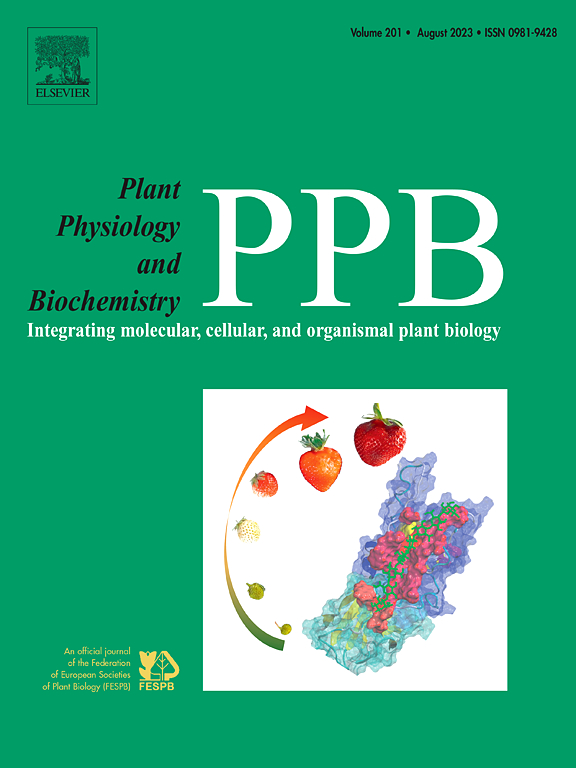Significance of glutathione in the hormesis effect: a case study of the relationship between heavy metal Cd and monitoring plant Tillandsia ionantha
IF 5.7
2区 生物学
Q1 PLANT SCIENCES
引用次数: 0
Abstract
With the impact of human activities on the global environment intensifies, how different organisms adapt to environmental stressors has become a critical issue, especially to the most toxic heavy metals. Hormesis effect is an effective way to adapt to the harsh environmental changes, and glutathione (GSH) has long been considered to play an important role in the generation of hormesis, but the underlying mechanisms have not been thoroughly investigated. This experiment selected heavy metal monitoring plant Tillandsia ionantha as the experimental material and subjected it to cadmium (Cd) stress with different time gradients. The activity of 5 GSH-related enzymes, the expression of 5 GSH-related functional genes, and the subcellular distribution of GSH were measured. The results showed that among all 13 biomarkers, 8 exhibited hormesis effects, accounting for 62 %, significantly higher than the frequencies of other dose-response types. With prolonged Cd treatment duration, the increase in GSH content was more pronounced in leaf mitochondria, and only mitochondrial GSH content showed a significant positive correlation with Cd content, suggesting high and stable GSH levels in mitochondria appear to be critical under environmental stress conditions. Notably, the expression of the four GSH-related functional genes peaked on the second day. Factor analysis also indicated that these genes played a positive regulatory role in hormesis, suggesting that GSH-related genes may respond more rapidly to Cd stress and play a more sensitive regulatory role in the formation of hormesis. The early activation of GSH functional genes and the optimization of GSH distribution at the subcellular level are likely the core drivers of hormesis formation, which has important implications when designing strategies aiming to promote beneficial hormesis effects in organisms.

谷胱甘肽在激效效应中的意义:以重金属镉与监测植物蓝莲为例
随着人类活动对全球环境影响的加剧,不同生物如何适应环境胁迫已成为一个关键问题,特别是对毒性最强的重金属。激效效应是适应恶劣环境变化的有效途径,谷胱甘肽(GSH)长期以来被认为在激效的产生中起重要作用,但其潜在机制尚未深入研究。本试验选择重金属监测植物铁莲为试验材料,对其进行不同时间梯度的镉胁迫。测定5种GSH相关酶活性、5种GSH相关功能基因表达及GSH亚细胞分布。结果表明,13种生物标志物中有8种具有激效效应,占62%,显著高于其他剂量效应类型的频率。随着Cd处理时间的延长,叶片线粒体GSH含量的增加更为明显,只有线粒体GSH含量与Cd含量呈显著正相关,表明在环境胁迫条件下,线粒体中较高且稳定的GSH水平似乎至关重要。值得注意的是,4种gsh相关功能基因的表达在第2天达到高峰。因子分析还表明,这些基因在激效中发挥正向调控作用,提示gsh相关基因可能对Cd胁迫反应更迅速,在激效形成中发挥更敏感的调控作用。GSH功能基因的早期激活和亚细胞水平GSH分布的优化可能是激效形成的核心驱动因素,这对于设计旨在促进生物体内有益激效的策略具有重要意义。
本文章由计算机程序翻译,如有差异,请以英文原文为准。
求助全文
约1分钟内获得全文
求助全文
来源期刊
CiteScore
11.10
自引率
3.10%
发文量
410
审稿时长
33 days
期刊介绍:
Plant Physiology and Biochemistry publishes original theoretical, experimental and technical contributions in the various fields of plant physiology (biochemistry, physiology, structure, genetics, plant-microbe interactions, etc.) at diverse levels of integration (molecular, subcellular, cellular, organ, whole plant, environmental). Opinions expressed in the journal are the sole responsibility of the authors and publication does not imply the editors'' agreement.
Manuscripts describing molecular-genetic and/or gene expression data that are not integrated with biochemical analysis and/or actual measurements of plant physiological processes are not suitable for PPB. Also "Omics" studies (transcriptomics, proteomics, metabolomics, etc.) reporting descriptive analysis without an element of functional validation assays, will not be considered. Similarly, applied agronomic or phytochemical studies that generate no new, fundamental insights in plant physiological and/or biochemical processes are not suitable for publication in PPB.
Plant Physiology and Biochemistry publishes several types of articles: Reviews, Papers and Short Papers. Articles for Reviews are either invited by the editor or proposed by the authors for the editor''s prior agreement. Reviews should not exceed 40 typewritten pages and Short Papers no more than approximately 8 typewritten pages. The fundamental character of Plant Physiology and Biochemistry remains that of a journal for original results.

 求助内容:
求助内容: 应助结果提醒方式:
应助结果提醒方式:


